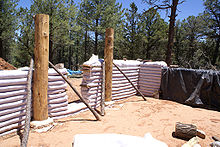- Nader Khalili
-
Nader Khalili (February 22, 1936, Tehran – March 5, 2008, Los Angeles) was an Iranian-born architect, writer, and humanitarian who received his philosophical and architectural education in Iran, Turkey, and the United States.
In 1970 he was licensed by the State of California and practiced architecture in the U.S. and around the world. Khalili was known for his innovation into the Geltaftan Earth-and-Fire System known as Ceramic Houses and the Earthbag Construction technique called Superadobe. His designs are heavily inspired by traditional arid house designs in his homeland Iran. He was involved with Earth Architecture and Third World Development since 1975, and was a U.N. consultant for Earth Architecture.
He developed his Super Adobe system in 1984, in response to a NASA call for designs for human settlements on the Moon and Mars. The project had been completely theoretical until the Persian Gulf War when refugees were sent into Iran. When this occurred Khalili partnered with the United Nations Development Programme (UNDP) and the United Nations High Commissioner for Refugees (UNHCR) and applied his research to emergency shelters.
In 1991 he founded the California Institute of Earth Art and Architecture (Cal-Earth), where he taught his Superadobe building technique. Although Khalili's work received mixed support in his native country, arguably due to social paradigms and political unrest, he became a prominent American leader on the value of ethically based architecture, where the needs of the homeless are considered above all else.
Khalili wrote books on his architectural philosophy & techniques as well as translations of poetry from Rumi, the poet he considered instrumental in his design inspiration.
Nader Khalili died on Wednesday, March 5, 2008.
Bibliography
- Racing Alone
- Ceramic Houses and Earth Architecture: How to Build Your Own
- Sidewalks on the Moon
- Rumi, Fountain of Fire
- Rumi, Dancing the Flame
Awards
In 1984, Khalili received the award for “Excellence in Technology” from the California Council of the American Institute of Architects (CCAIA) for his innovation of the Ceramic House System. In 1987 he received a Certificate of Special Recognition from the U.N. International Year of Shelter for the Homeless and U.S. Department of Housing and Urban Development (HUD) for his project "Housing for the Homeless: Research and Education." In 2004 Khalili won the Aga Khan Award for Architecture for Superadobe.
External links
- Khalili, Nader. "Nader Khalili." Cal-Earth. 19 Jan. 2007 http://www.calearth.org/khalili.htm
- Katauskas, Ted. "Dirt-Cheap Houses from Elemental Materials." Architecture Week. Aug. 1998. 19 Jan. 2007 http://www.architectureweek.com/2000/0517/building_1-1.html
- Husain, Yasha. "Space-Friendly Architecture: Meet Nader Khalili." Space.com. 17 Nov. 2000. 19 Jan. 2007 http://www.space.com/peopleinterviews/khalili_profile.html
- Sinclair, Cameron, and Kate Stohr. "Superadobe." Design Like You Give a Damn. Ed. Diana Murphy, Adrian Crabbs, and Cory Reynolds. Ney York: Distributed Art Publishers, Inc., 2006. 104-13.
- Kellogg, Stuart, and James Quigg. "Good Earth." Daily Press. 18 Dec. 2005. Freedom Communications, Inc. 22 Jan. 2007 http://www.vvdailypress.com/2005/113489280061585.html
- Alternative Construction: Contemporary Natural Building Methods. Ed. Lynne Elizabeth and Cassandra Adams. New York: John Wiley & Sons, Inc., 2000.
- Hunter, Kaki, and Donald Kiffmeyer. Earthbag Building. Gabriola Island, BC: New Society Publishers, 2004.
- Kennedy, Joseph F. "Building With Earthbags." Natural Building Colloquium. NetWorks Productions. 14 Feb. 2007 http://www.networkearth.org/naturalbuilding/earthbags.html
- Aga Khan Development Network. "The Aga Khan Award for Architecture 2004." Sandbag Shelter Prototypes, various locations. 14 Feb. 2007 http://www.akdn.org/agency/akaa/ninthcycle/page_03txt.htm
- The Green Building Program. "Earth Construction." Sustainable Building Sourcebook. 2006. 14 Feb. 2007 http://www.austinenergy.com/Energy%20Efficiency/Programs/Green%20Building/Sourcebook/earthConstruction.htm
- NBRC. "NBRC Misc. Photos." NBRC: Other Superadobe Buildings. 10 Dec. 1997. 14 Feb. 2007 http://users.pstel.net/goshawk/other.htm
- CCD. "CS05__Cal-Earth SuperAdobe." Combating Crisis with Design. 20 Sept. 2006. 14 Feb. 2007 http://combatingcrisiswithdesign.blogspot.com/2006/09/cs05cal-earth-superadobe.html
- American Institute of Architects. A Conversation with Nader Khalili. 2004. 14 Feb. 2007 http://www.aia.org/nwsltr_print.cfm?pagename=aiaj_a_20051201_khalili
Categories:- 1936 births
- 2008 deaths
- Iranian architects
- American people of Iranian descent
- American architects
Wikimedia Foundation. 2010.

